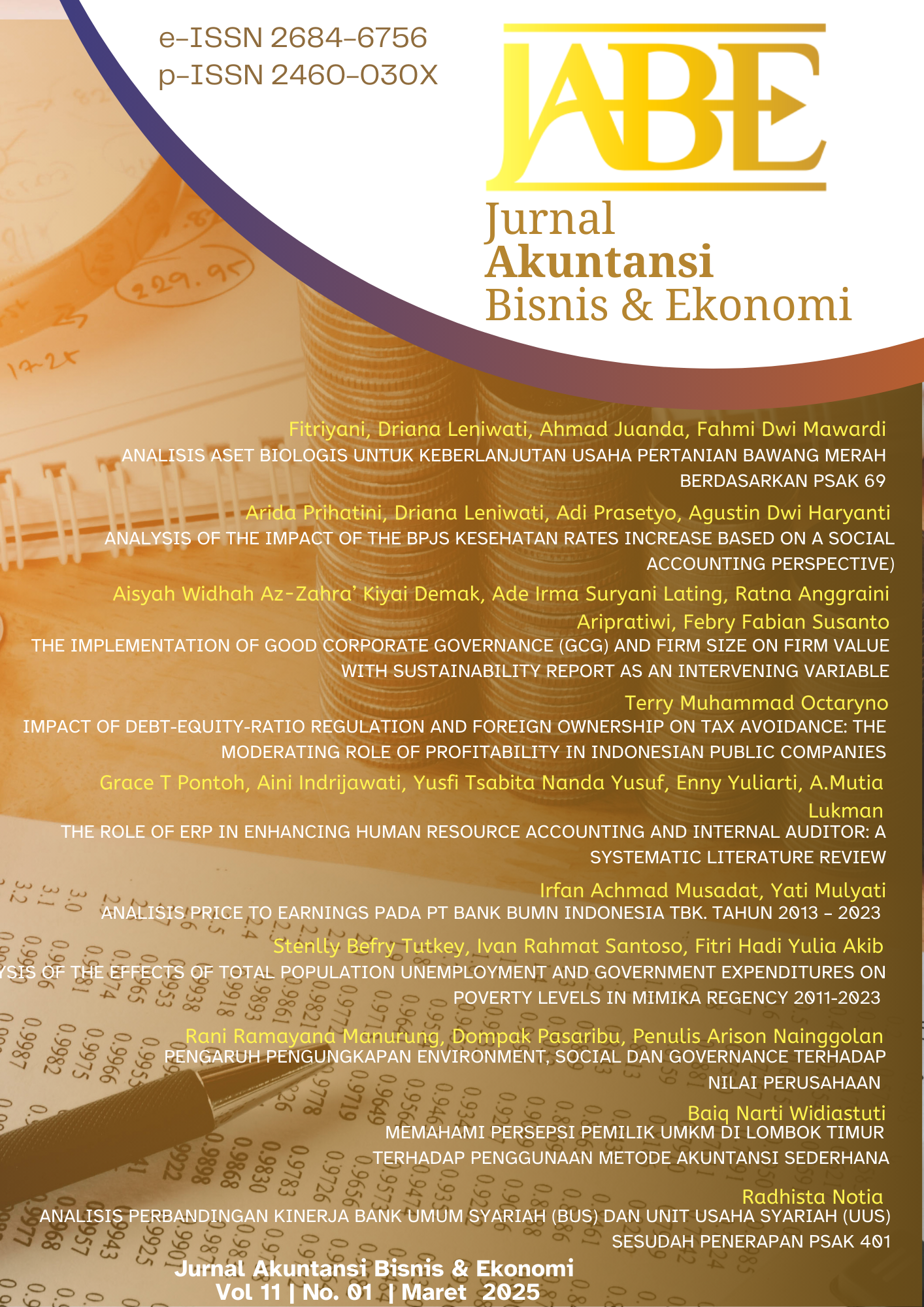Analisis Perbandingan Kinerja Bank Umum Syariah (BUS) dan Unit Usaha Syariah (UUS) Sesudah Penerapan PSAK 401
ANALISIS PERBANDINGAN KINERJA BANK UMUM SYARIAH (BUS) DAN UNIT USAHA SYARIAH (UUS) SESUDAH PENERAPAN PSAK 401
DOI:
https://doi.org/10.33197/jabe.vol11.iss1.2025.2614Keywords:
PSAK 401, Islamic Commercial Banks, Islamic Business Units, Sharia Accounting StandardsAbstract
Research This study analyzes the impact of the implementation of PSAK 401 on the performance of Islamic Commercial Banks (BUS) and Islamic Business Units (UUS) in Indonesia. (BUS) and Sharia Business Units (UUS) in Indonesia. Using a quantitative approach with a comparative case study design, this research compares the main financial ratios after the implementation of PSAK 401, as well as between key financial ratios before and after the implementation of PSAK 401, as well as between BUS and UUS. BUS and UUS. Secondary data in the form of monthly financial reports from Bank Syariah Indonesia and Bank CIMB Niaga Syariah for the period 2018-2023 were analyzed using a t-test and trend analysis. The results showed a significant increase in CAR, ROA, and a decrease in Gross NPF and BOPO after the implementation of PSAK 401 in both types of entities. in both types of entities. UUS consistently showed superior performance compared to BUS in most indicators. The implementation of PSAK 401 proved effective in improving the quality of financial reporting and performance of Islamic banking performance, although there are differences in the level of impact between BUS and UUS. The findings This finding has important implications for regulators in adjusting policies to support the development of Islamic banking, as well as for practitioners in optimizing the quality of financial reporting. policies to support the development of BUSs, as well as for practitioners in optimizing implementation of PSAK 401 and improving management practices.
Downloads
References
Arrizky, N. A. (2022). Analisis Perbandingan Tingkat Kesehatan Bank Umum Syariah Sebelum Dan Sesudah Terdampak Covid-19. Jurnal Proaksi, 9(4), 427–437. https://doi.org/10.32534/jpk.v9i4.3414
Bharata, R. W., Susilo, G. F. A., & Nugraheni, A. P. (2020). International Financial Reporting Standards (IFRS) dan Proses Pengadopsiannya di Indonesia. Jurnal Bisnis Darmajaya, 06(02), 10–26. https://jurnal.darmajaya.ac.id/index.php/JurnalBisnis/article/view/1951
BSI. (2023). EKSPANSI DAN AKSELERASI BISNIS UNTUK PERTUMBUHAN BERKELANJUTAN LAPORAN. Laporan Tahunan 2023 PT Bank Syariah Indonesia TBK. https://ir.bankbsi.co.id/misc/AR/AR2023-ID.pdf
Budiyah, F. (2024). Analisis Perbandingan Kinerja Bank Umum Syariah (Bus) Dan Unit Usaha Syariah (Uus). Ekonomica Sharia: Jurnal Pemikiran Dan Pengembangan Ekonomi Syariah, 10(1), 127–148. https://doi.org/10.36908/esha.v10i1.1237
Chandra, V., Ilat, V., & Kalalo, M. Y. B. (2020). Penerapan Perlakuan Akuntansi Aset Tetap Berdasarkan Psak No. 16 Pada Hotel Arviel Gorontalo. Going Concern: Jurnal Riset Akuntansi, 15(3), 399. https://doi.org/10.32400/gc.15.3.30061.2020
Faiz, I. (2010). Ketahanan Kredit Perbankan Syariah Terhadap Krisis Keuangan Global. La_Riba, 4(2), 217–237. https://doi.org/10.20885/lariba.vol4.iss2.art5
Firmansyah, A., Rizky, M., & Qodarina, N. (2022). Manajemen Laba Sebelum dan Setelah Penerapan PSAK 71 pada Perusahaan Subsektor Perbankan di Indonesia. Owner, 6(2), 1363–1372. https://doi.org/10.33395/owner.v6i2.706
Hamidi, M. L., & Worthington, A. (2020). Islamic Banking in Indonesia: Emergence, Growth, and Prospects (pp. 38–60). https://doi.org/10.4018/978-1-7998-1611-9.ch003
Harindra, A. Z., Shoba, H. K., & Firmansyah, A. (2023). Dampak Penerapan PSAK 71 Terhadap Tingkat Profitabilitas Perusahaan Perbankan Di Indonesia. Akuntansiku, 2(2), 67–73. https://doi.org/10.54957/akuntansiku.v2i2.379
Hidayah, N., Amanda, A., & Az – Jahra, S. (2024). Menelaah Tantangan Bank Syariah dalam Menghadapi Perkembangan di Era Digital. Journal of Waqf and Islamic Economic Philanthropy, 1(3), 1–8. https://doi.org/10.47134/wiep.v1i3.295
Hidayat, F. (2023). Pengaruh Prosedur Pembiayaan, Kualitas Pelayanan dan Tingkat Bagi Hasil terhadap Keputusan Pengambilan Pembiayaan Mudharabah pada Bank Syariah Indonesia Jambi. Jurnal Manajemen Pendidikan Dan Ilmu Sosial, 4(2), 675–690. https://doi.org/10.38035/jmpis.v4i2.1639
Iryani, L. D. (2024). Quality of Financial Reporting and the Level of Compliance with SAS: A Case Study of Islamic Banking in Indonesia. International Conference on Accounting and Finance, 2, 421–439.
Izzaturrahman, M. D. (2022). Analisis Pertumbuhan Aset, Dana Pihak Ketiga dan Pembiayaan Perbankan Syariah Pasca Covid-19. Journal of Economics and Social Sciences (JESS), 2(1), 62–72. https://doi.org/10.59525/jess.v2i1.264
Maulana, R., Rahayu, W. S., & Anwar, S. (2024). Analisis Penerapan Syariah Accounting pada Penyusunan Laporan Keuangan Perusahaan JSY Relevansinya atas PSAK Syariah No . 401. 3(401).
Renita Pratiwi, Moh. Mahrus, & Alias Candra. (2022). Analisis Perbandingan Bank Umum Syariah dengan Unit Usaha Syariah dari Aspek Efisiensi, Kualitas Aset, dan Stabilitas Keuangan. 1(1), 105–118.
Santoso, T., Firmansyah, E. A., Sapulette, M. S., & Setiawan, M. (2023). The Impact of Industry Concentration on Stability: The Case of Indonesian Islamic-Commercial Banks. International Journal of Islamic Economics and Finance (IJIEF), 6(2), 201–224. https://doi.org/10.18196/ijief.v6i2.17892
Sri Nurhayati, W. (2023). Akuntansi Syariah di Indonesia, Edisi 5. Penerbit Salemba.
Downloads
Published
How to Cite
Issue
Section
License
Copyright (c) 2025 Radhista Notia

This work is licensed under a Creative Commons Attribution-NonCommercial-ShareAlike 4.0 International License.
Submission of a manuscript implies that the submitted work has not been published before (except as part of a thesis or report, or abstract); that it is not under consideration for publication elsewhere; that its publication has been approved by all co-authors. If and when the manuscript is accepted for publication, the author(s) still hold the copyright and retain publishing rights without restrictions. Authors or others are allowed to multiply the article as long as not for commercial purposes. For the new invention, authors are suggested to manage its patent before published. The license type is CC-BY-SA 4.0.












